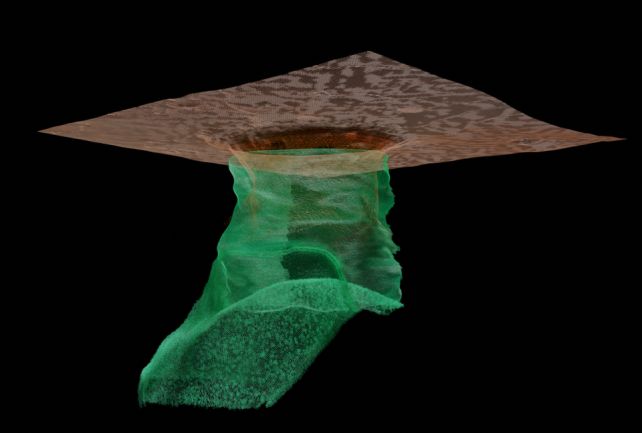It's really not going to be easy for humans to set up a habitat on the Moon, but a new discovery could alleviate some problems.
An analysis of radar data suggests a gaping hole in the lunar crust could lead to a network of caves which future lunar explorers might use for shelter. We've known about the holes called "skylights" in the surface of the Moon for some time; now, we finally have evidence that they exist.
"These caves have been theorized for over 50 years, but it is the first time ever that we have demonstrated their existence," says astronomer Lorenzo Bruzzone of the University of Trento in Italy.
The environment on the Moon is very different to the one we evolved in, so isn't very kind to human physiology. There's no atmosphere to breathe, for one. And then there are the temperatures. A day on the Moon lasts around 14 days, as does its night. During the day, temperatures can reach as high as 121 degrees Celsius (250 Fahrenheit), but then plunge down to -133 degrees Celsius (-208 Fahrenheit) after sundown.
Not to mention the solar and cosmic radiation. Earth's atmosphere protects us from the worst of it; the Moon constitutes a radiation environment that would be considered hazardous to human health.
Cue lava tubes. These are created when lava solidifies at the surface while continuing to flow underneath. Eventually, the underground current of lava drains away, leaving a hollow cavity under a now-solid volcanic rock layer – a natural cave.
They can happen anywhere there has been volcanic activity. We have them here on Earth, they've been spotted on Mars, and whole networks are thought to exist on the Moon.
These lunar lava tubes are of keen interest to scientists designing lunar exploration missions, since they would provide a human Moon base protection from the harsh surface environment. But positively identifying a cave system just from holes in the lunar surface has been a bit of a challenge.

Now, led by astronomer Leonardo Carrer of the University of Trento, a team of researchers says that they have finally made such an identification.
The observations come in the form of radar data collected in 2010 by NASA's Lunar Reconnaissance Orbiter. As it flew over an ancient lunar basalt plain called the Sea of Tranquillity, it spotted a hole in the surface of the Moon; a skylight that appears when part of a lava tube caves in.
"Years later we have reanalyzed these data with complex signal processing techniques we have recently developed, and have discovered radar reflections from the area of the pit that are best explained by an underground cave conduit," Bruzzone says.
"This discovery provides the first direct evidence of an accessible lava tube under the surface of the Moon."
The next step was to model the shape of the tunnel beneath the skylight. The best explanation for the structure, the researchers found, was a lava tube extending from the skylight, into the interior of the Moon.
Now, we can't just put down any old where on the Moon. The landing site, particularly for a crewed mission, needs to be carefully considered. We've already sent humans to the Sea of Tranquility so it's unlikely to be top of the list for the next mission, especially since the polar regions have exciting features to check out such as craters with possible water ice.
But having found one lava tube on the Moon means that there are likely to be more up there that are waiting to be discovered. And identifying where they are could help narrow down the best sites for a long-term lunar base.
"This research," says planetary geologist Wes Patterson of Johns Hopkins University, "demonstrates both how radar data of the Moon can be used in novel ways to address fundamental questions for science and exploration and how crucial it is to continue collecting remotely sensed data of the Moon."
The research has been published in Nature Astronomy.



No comments:
Post a Comment